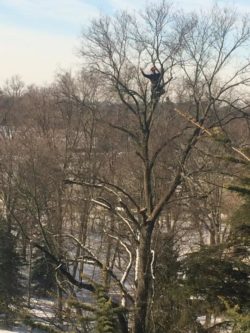Tree Pruning Frequency
One of the very key details that I can often look to in whether a tree was pruned well or not is the space of time between pruning. Tree pruning can have very beneficial or very negative consequences for the health and structure of a tree. This article is going to cover the details of how often you should be having your trees pruned.
Young vs Mature Trees
Before I get too deep into the main part of tree pruning, I first need to mention that the frequency of pruning is going to in part depend on the age of a tree.
Young trees
A lot more pruning should be performed when the tree is young and developing. This may be needed every year for some species or at least every 2 to 3 years for young trees. By young, I’m referring to trees from newly planted to those that are over 20 feet or 4-8 inches in trunk diameter. This early pruning should be focusing on future canopy size. Pruning that maintains a strong central leader so there are no future defects that will develop. And careful planning to identify the lowest permanent branch that will eventually be the bottom of the canopy.

Tree pruning wounds should be small and clean with no damage to the bark or the trunk tissue.
Mature Trees
Once a tree is mature and has its overall canopy shape and its near its mature height, pruning should be very infrequent. Additionally, that pruning should only be to smaller limbs, dead or diseased limbs, or those limbs broken in a storm. Mature trees should only be pruned for maintenance, not clearance or things that were neglected when it was younger, if possible. Removing large limbs or portions of a mature tree creates several major potential issues.
Proper Pruning
When proper tree pruning is performed well on growing trees, you should be able to go several years before additional pruning is necessary. As I have mentioned in previous articles (WHEN and BASICS), there must be a plan before the tree is pruned. There should also be a reason for the pruning. Trees do not need regular pruning once they have a good established central leader. All of the other methods with pruning to raise a canopy, reduce it, or thin it are for reasons we want the tree to do. Make sure your arborist has a clear plan that can be written on paper.
Proper pruning should have the following results:
- Clean cuts with no tears to the bark
- It should be hard to tell that work was even done sometimes
- Most trees should be able to go 3-6 years between prunings
- Leaves and branches all the way from the trunk to the tips.
Poor Pruning
Unfortunately, this is something I come across way too frequently. People are having their trees pruned every year or sometimes even multiple times a year. You are getting ripped off, plain and simple. Either knowingly by the person doing the work. Or they are unknowingly just doing work without any understanding for the tree. Either way, its more appropriately trimming and not pruning.
Poor pruning does several unfavorable things to your tree:
- Creates excess wounding and stress
- Excessive trunk sprouts
- invites more pests and diseases to attack the tree
- Costs more money to maintain
- Eventually leads to earlier decline and death of a tree.

A good arborist should be able to reach all the parts of a tree to do the work. This is me about 85 feet up in an elm doing ice damage cleanup in Longwood Gardens, Pennsylvania.
How to Spot Poor Pruning
-
Frequent pruning
- If your tree is being pruned on a regular basis, it possible they are being pruned incorrectly.
-
Tear Cuts
- Each cut should be clean, with no tears to the bark or damage to the trunk.
-
Large Wounds
- Generally, there shouldn’t be limbs being removed if they are larger around than a volleyball. Even that is on the large side. Most cuts should be made to limbs with diameters of 6-8 inches and smaller.
-
Cuts low on the tree or tree climbed with spikes
- If the person doing the pruning cannot access the entire tree to make the cuts where they need to be, they should not be pruning your tree.
-
Lion Tailing
- This is an all to common practice of inexperienced tree workers. Lion Tailing is when all the limbs or small branches with leaves are pruned off in the interior of a tree with only leaves at the very end of the branch or canopy.
Hopefully this information has helped you in determining if your trees are being pruned properly or if they need to be pruned again. If you

